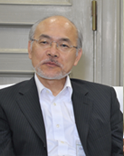Adopted into the Sumitomo family when he was 29 years old, Tomoito acquired Seifukan Villa from the Tokudaiji family in 1907 (40th year of the Meiji era). It was at his brother Tomoito’s suggestion that Kinmochi decided on Seifukan as his residence in Kyoto. As it was so full of childhood memories, Kinmochi may well have been delighted to follow his brother’s advice.
Even after the capital moved from Kyoto to Tokyo as a consequence of the Meiji Restoration, a residence in Kyoto was a status symbol for business people and politicians. For Kinmochi, who was from a kuge family and leading the government as prime minister in his first administration, it was only natural that he should have a fine residence in Kyoto.
Having discussed the matter, Tomoito and Kinmochi commissioned Jinbee Yagi, Jr. for the buildings and Jihei (Ueji) Ogawa VII for the garden. Kinmochi provided detailed instructions covering such matters as building materials, overall design, and the arrangement of stones in the garden. Kinmochi’s preferences combined with Tomoito’s artistic inclinations are reflected in Seifuso Villa, a dignified and tranquil residence eminently suitable for a statesman who was leading Japan into an extraordinary new era.

 EN
EN






